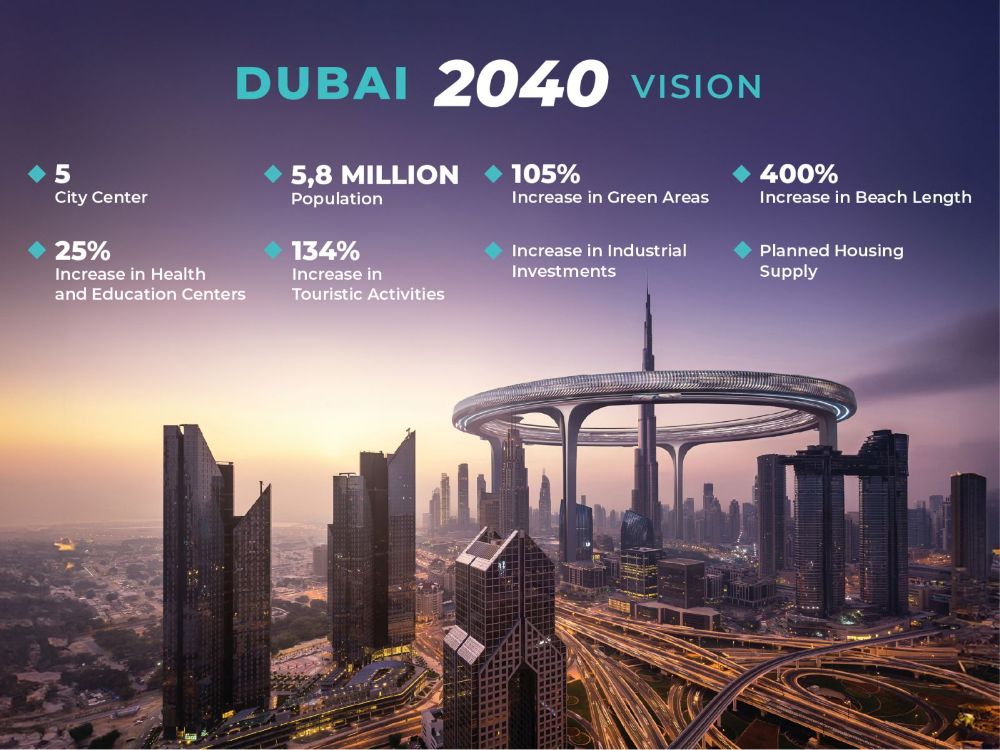
Dubai 2040 Urban Master Plan: A Vision That Will Reshape Real Estate Markets
Introduction
Dubai has long been synonymous with bold urban planning, iconic architecture, and aggressive growth. The unveiling of Dubai’s 2040 Urban Master Plan marks its latest leap into long-term thinking, combining sustainability, smart infrastructure, and population management into a two-decade roadmap. As real estate stakeholders—investors, developers, homebuyers—seek to align with future trends, the 2040 plan offers both opportunity and risk.
In this article, we’ll explore:
- What the Dubai 2040 plan broadly entails
- Key mechanisms by which it can influence real estate supply, demand, and pricing
- Projected effects on ROI across residential, commercial, and mixed-use sectors
- Strategic considerations and warnings for investors
- How to position yourself now to benefit
What Is the Dubai 2040 Master Plan?
The Dubai 2040 Urban Master Plan is a structural planning framework introduced to guide Dubai’s growth over the next twenty years. 11prop.com+3dm.gov.ae+3Damac Properties+3
Some of the central features and targets include:
- Projected population growth from around 3.3–3.8 million today to 5.8 million residents by 2040 (and a daytime population potentially higher) dm.gov.ae+4Damac Properties+4AZCO+4
- Land-use rebalancing: expanding public parks, green corridors, and natural reserves so that 60 % of Dubai’s land is allocated to nature or open spaces DrivenProperties+4Damac Properties+4dm.gov.ae+4
- Infrastructure and mobility upgrades: ensuring that 55 % of the population lives within 800 m of a public transportation hub, enhancing transit corridors, walking/cycling paths, and reducing commute times AZCO+411prop.com+4dm.gov.ae+4
- Emphasis on mixed-use and decentralized urban hubs: five key “centres” (including Downtown/Business Bay, Deira/Bur Dubai, Dubai Marina/JBR, Expo zone, and Dubai Silicon Oasis) will be focal nodes of activity and development roseislandre.com+411prop.com+4Damac Properties+4
- Growth in health, education, and public amenity infrastructure by around 25 % AZCO+2dm.gov.ae+2
- Supportive planning legislation: a new “Law No. 16 of 2023” governing urban planning, clarifying roles of authorities in development, introducing oversight and guidelines for sustainable development, and streamlining approvals for projects consistent with the master plan 11prop.com+3dm.gov.ae+3Keltandcorealty+3
- Increased allocation of land for commercial / industrial uses (168 km² dedicated) to bolster economic diversification Keltandcorealty+4Damac Properties+4dm.gov.ae+4
In short, Dubai is positioning itself not just for expansion, but for balanced, sustainable, connected growth over the next two decades.
How the Master Plan Can Influence Real Estate Prices & ROI
To understand the likely impact, one must trace how the plan affects the fundamentals of real estate: demand, supply, risk, and desirability. Below are the leading channels:
1. Demand Pressure from Population & Economic Growth
- A growing resident count naturally exerts upward pressure on housing demand. The plan’s population forecast suggests a ~50-70 % increase in demand over two decades.
- Dubai’s plan is also linked to diversification strategies—boosting sectors such as tourism, technology, business services, and creative industries. More jobs = more migration = more demand for residential, office, and retail real estate.
- Improved livability, infrastructure, and environmental amenities under 2040 will attract both high-net-worth individuals and professionals, increasing demand especially in premium segments.
2. Supply Reallocation, Land Scarcity & Zoning Effects
- Finite land in Dubai means that zones earmarked for green buffers, environmental reserves, or transit corridors reduce the pool of developable land for conventional real estate. This scarcity in prime zones can drive land and property prices upward.
- The plan’s zoning and regulatory changes will likely favor mixed-use, sustainable, higher-density development in designated hubs, while disincentivizing sprawling, low-density suburban sprawl. Properties in or near these hubs tend to appreciate more.
- The plan also intends more streamlined approvals for projects that align with master-plan principles. For example, “faster approval systems” have been introduced to reduce project approval times by ~60 % for developments in line with policies.
- Developers will increasingly be required to comply with green building standards, sustainability criteria, and infrastructure contributions—raising development cost, but also enhancing asset value and longevity.
3. Amenity Value, Connectivity & Premium Perception
- Properties near enhanced transit hubs, parks, open space, and community amenities often command price premiums. As more of the city becomes walkable, sustainable, and transit-oriented, adjacency to these features becomes a key value driver.
- Mixed-use developments reduce “time cost” of commuting and often embed retail, office, and leisure within reach, which increases daily convenience and attractiveness. Demand for such lifestyle-oriented real estate rises.
- As global capital flows consider ESG (Environmental, Social, Governance) and sustainable urbanism, real estate aligned with 2040’s green and smart infrastructure may attract premium pricing and lower capitalization rates.
4. Risk Reduction & Investor Confidence
- Having a clear, legislated master plan reduces regulatory uncertainty. Investors can better predict growth corridors, zoning changes, infrastructure rollout, and thus choose assets with more confidence.
- The integration of oversight, compliance, and enforcement in the master plan helps limit speculative overbuilding in undesirable zones, mitigating “ghost asset” risk.
- The shift in developer practices (for example, bringing construction in-house to improve delivery timing) is already observable in 2025, likely to reduce delays and enhance project confidence.
Projected Effects on ROI: Where & How Much?
While it is impossible to guarantee exact numbers two decades ahead, several emerging trends and estimates point to meaningful upside—especially for well-timed, well-located investments.
1. Residential Sector
- Capital Appreciation: Properties in strategic districts—those aligned with the new transit and hub corridors—may outpace average market growth. In some sources, developers and analysts project double-digit annual growth in premium corridors over medium term.
- Rental Yields: As demand increases and supply remains constrained in quality zones, rental yields may stabilize or improve slightly, especially for modern, green, amenity-rich properties. Some emerging communities already quote yields in the 5–7 % range or higher.
- Off-plan Advantages: Buying off-plan (i.e. before construction) allows entry at lower per-unit prices and capitalizing on appreciation as infrastructure arrives. This strategy is likely to be more profitable in zones earmarked for growth under 2040.
- Affordable Housing Boost: The plan includes a boost in affordable housing inventory (some sources cite ~17,000 new units) and mixed-income strategies, which can create stable, lower-risk investment opportunities with solid yields.
2. Commercial & Mixed-Use Real Estate
- Office / Co-working Spaces: As Dubai continues diversifying economically, demand for premium offices, flex spaces, and business hubs in the growth corridors is expected to rise.
- Retail & Hospitality: With increased footfall in new hubs, retail (especially ground-floor in mixed-use) and hospitality in high-traffic zones may see stronger revenues and higher occupancy. Tourism and hotel segments will benefit from connectivity and green environment improvements.
- Integrated Assets: Properties that combine residential, retail, office, and leisure (“live-work-play”) models are likely to command premium valuations and stronger ROI, as they reduce reliance on single-use demand cycles.
3. Risk & Downside Pressures
- Supply Overhang: As with any booming real estate market, a glut of supply—especially if developers overshoot demand—can depress prices temporarily. Notably, Fitch Ratings projected a possible double-digit decline (up to ~15 %) in real estate prices in 2025–26 due to surging deliveries.
- Timing & Phasing Gaps: Infrastructure rollout, approvals, and execution may lag forecast. Properties in zones scheduled for much later infrastructure may not appreciate as rapidly.
- Regulatory / Policy Shifts: Even with a master plan, changes in incentives, visa policies, taxation, or macroeconomic shifts may affect foreign investment appetite.
- Market Cycles & Exogenous Shocks: Global interest rates, currency fluctuations, geopolitical events, or local economic slowdowns could dampen demand or capital flows.
4. Expected ROI Ranges (Illustrative)
While speculative, analysts commonly cite medium-term (5–10 year) returns in prime zones in the 8–12 % annualized capital appreciation plus 4–7 % rental yield as plausible benchmarks. Lower-rated zones or non-core areas may yield lower returns but less price volatility. Over the full 20-year horizon, well-selected assets in alignment with the 2040 vision may see 3x–5x total value growth, depending on location, asset class, developer, and timing.

Strategic Takeaways & Recommendations
To harness the 2040 plan’s potential and mitigate risks, investors should consider the following strategies:
- Follow the Infrastructure
Prioritize assets near proposed transit lines, mobility corridors, hub centers, and planned amenities. Early identification of “next nodes” is key. - Select Developers with Vision & Credibility
Developers aligned with 2040 goals—and with demonstrated delivery track record—offer better reliability. Their projects are more likely to benefit from expedited approvals, higher standards, and market appeal. - Favor Mixed-Use, Green, Smart Projects
Properties that integrate sustainability, smart tech, and lifestyle amenities will command premium valuation. They are more future-proof under evolving regulatory and consumer expectations. - Balance Risk via Diversification
Don’t overconcentrate in a single district or property type. Mix between core/high premium zones and emerging growth corridors. Employ off-plan + ready assets to diversify timing risk. - Adopt a Long-Term Horizon
The 2040 objectives will be realized over many years. Some gains will accrue early in the “low-hanging fruit” corridors, others deeper in the timeline. Investors should plan for a 7–15 year horizon at minimum. - Monitor Regulatory & Policy Changes
Stay alert to planning amendments, taxation changes, visa reforms, incentives for sustainable buildings, or evolving zoning rules. - Stress-Test for Downturns
Ensure that cashflows and mortgages can survive moderate corrections. Real estate is cyclical, and even Dubai’s market has cooled before.
Conclusion
The Dubai 2040 Urban Master Plan is not a mere policy document — it is a commitment to shaping the city’s spatial, economic, and social future. For real estate, it represents a structural shift: aligning supply, demand, amenities, and infrastructure in a more coherent, sustainable, and investor-friendly manner.
While risks remain, the opportunities are significant. Well-positioned properties in emerging hub corridors—with strong connectivity, amenity access, and alignment with sustainability standards—are likely to yield superior ROI over the long run.
Related Articles

Escrow Accounts in Dubai: How They Protect Your Real Estate Investment
Dubai has become one of the world’s most attractive destinations for real estate investors. With strong government regulations, clear processes, and transparent systems, property buyers often ask: Is real estate investment in Dubai safe? One of the key answers lies in the Escrow account system. This article explains what an Escrow account is, how it protects buyers, and why it plays a major role in reducing risk in Dubai’s property market.

Residence Permits in Dubai Through Real Estate Investment: Everything You Need to Know
Dubai continues to be one of the most attractive destinations globally for real-estate investment — not only because of its world-class infrastructure and tax-friendly environment, but also because foreign investors can secure residence permits via property ownership. This article outlines the two main investment-linked residence routes in Dubai, details their requirements, explains how each works and highlights recent regulatory enhancements from the UAE government.

Why Al Marjan Island Is the Middle East’s Most Promising Real Estate Investment Opportunity
Al Marjan Island, located in the Emirate of Ras Al Khaimah, is rapidly becoming one of the UAE’s most talked-about investment hotspots. With the launch of Wynn Al Marjan Island — the first legal casino resort in the Middle East — and limited remaining land for future development, investors are eyeing this prime location as a once-in-a-generation opportunity.
Comments (0)
You need to be logged in to comment